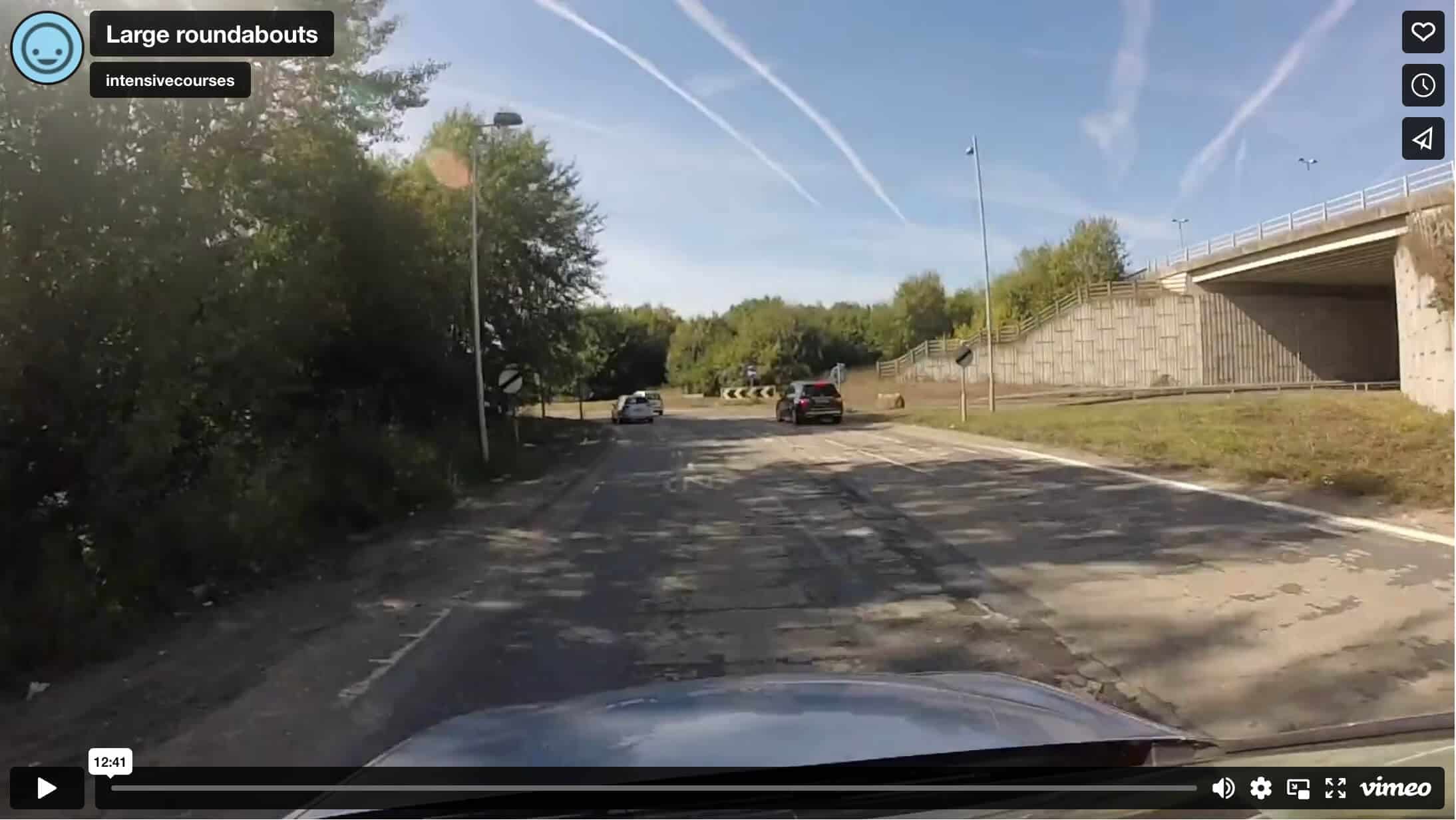Can You Change Lanes On A Roundabout, What Speed Limit & Rules UK
Our video takes you through with our lead driving instructor, showing you exactly how to approach, change lanes and exit while driving in the roundabout.
Changing lanes on a roundabout. Where to start…
If you want to know how to use a roundabout, in this video, we cover approaching a roundabout, how to enter, which lane to be in depending upon the turning you’re taking, changing lanes and how to drive through in order to come on and off a roundabout. We cover going left, straight-across the roundabout, right and doing a complete circuit of the roundabout to go back where we came from.
We also cover going off the roundabout onto a duel carriageway, and coming off a duel carriageway back onto a roundabout, and the difference between closed junctions and open junctions.
Our videos are ideal for people learning to drive, those wanting to refresh their memory and doe parents or friends looking for some guidance on roundabout techniques when learning how to teach someone to drive. Before we start, here are a couple of roundabout related questions we are often asked:
Can you change lanes in a roundabout? Yes you can and indeed have to as you drive around – we cover this more throughout the video.
Roundabout rules UK – straight ahead
While there are various rules that apply to the use of a roundabout, here are how to apply a rule, based on different types of roundabouts.
What signal should you give when you’re going straight ahead at a roundabout?
Going straight ahead at roundabout. Before entering a roundabout if going straight ahead you do not signal. You signal left to leave once passed the exit before your exit. The answer here also depends upon the size of the roundabout.
Do you indicate when going straight on at a roundabout in the UK?
In medium to big roundabouts it is important to indicate to leave when crossing straight through a roundabout.
On mini roundabouts you do not signal when leaving as it might confuse other drivers. They may think your parking up or taking the next left after the roundabout.
What is the roundabout speed limit in the UK?
There are no speed limits on Roundabouts, other than those already in force in the area. So if you are in a 20 mph zone, 30 limit etc., then abide by the speed limit you are currently in. The only caveat is that you need to be able to see that it is safe to proceed. i.e. on some mini roundabouts where it’s a closed junction you may need to stop to check there are no other vehicles crossing from the right. Other than that, make sure your speed on the roundabout is safe and appropriate for the driving conditions, as you would during any drive.
In the above video, our chief driving instructor goes through further notes about speed of approach, changing lanes and driving on a roundabout, so please refer to that also, or the transcript and summary below.
Video Transcript:
Hi, my name is Noel Gaughan; I’m the lead driving instructor over at Intensive Courses. Today, we’re going to be doing the larger roundabouts and joining duel carriageways.
Closed and open junctions at Roundabouts
Now the key to any roundabout is the speed of approach. You’ve got to work out if it’s a closed junction or an open junction. What we mean by that is can you see clearly to your right and straight ahead as you approach the roundabout. If you can’t see it’s a closed junction and if you can see, it’s an open junction.
We’re going to be approaching our first roundabout, as you can see there’s a national speed limit sign ahead, which indicates 60 miles per hour maximum speed. We’ll be going right at this roundabout so as you come in around the corner you’ll see the roundabout sign. And we’re looking to go to the M11, so we’re going to be going right.
We’ll check our mirrors and we’ll tell everyone where we’re going [right indicator is now on] Bring the speed down and then have a look to your right to see if any cars are coming. There are cars coming at the moment so I’m going to slow down and let them go and then move off.
Now when you’re going right on the roundabout it’s always wise to move over into the right hand lane and then when you’re about half way around start looking to your left and change lanes. And you can see a car on the left, I’m going to indicate that I’m coming across [left hand indicators are on] checking my blind spot as well making sure no cars are coming and now I’ve left the roundabout.
The next roundabout coming up to, we’re going to go to Stansted and that’s the second exit on the left. If you look ahead, you’ll see the left hand lane says left only and that’s for the first exit which we’re not going to. We’ll be going to the second exit, so we’ll stay on this lane here. There’s a green light, so I’m going through the junction and now I’m going to move toward the left hand lane. I’m going to indicate; first checking my mirrors to make sure it’s safe and then move across.
Now when you’re leaving a roundabout, it’s always wise to tell everyone you’re going to leave, so keep your [left] indicator on and move to the left as you leave.
Shortly we’ll be going to another roundabout where we’ll be following the signs again to Colchester and we’ll be going right.
Now when you’re going right at a roundabout, it’s always best to be in the right-hand lane. So I’m going to change lanes here on the duel carriageway and tell the cars what I’m doing [Indicating right] checking my blind spot and then moving across gently, keeping my speed up – at the moment I’m going a little over 50 mph.
As you approach the roundabout, do as you did before – check all the mirrors and tell everyone where we’re going [using indicators] and bring the speed down.
As you can see, there’s a little sharp bend here, so take your time, go into second gear, nice and gentle. Check if there are cars coming, in this case there are no cars coming so I’m going to move into the right-hand lane and I’m going to begin to pick up speed. Now as there are three lanes on this, I’m going to soon move to the left hand lane so I’m going to signal left, check my blind spot, make sure there’s nobody there and move gently across. You shouldn’t need to pull the wheel too tight, just very, very gently.
Now we’ll be leaving the roundabout again, so signal left to leave and look ahead you’ll see we’re joining a duel carriageway. Our lane disappears as the sign says, so we’ll need to get our speed up to match the cars on the other lane. If they’re doing fifty, then we must go fifty, if they’re going sixty, it’s wise to go sixty. It’s much easier to merge in if you’re going at the same speed as the other cars. So I’m going to tell them what I’m doing signal and keep the speed up and check my blind spot over my right shoulder that there’s nothing coming and merge in very gently while keeping the speed up. We’re doing 50 mph, now looking at the sign ahead we’ve got the national speed limit, The national speed limit on a duel carriageway is 70 mph,
Now we’re getting the speed up and in 5th gear going 60 mph and slowly getting the speed up.
Now we’re going to go to Stansted, which is on the left-hand lane, towards the airport. And we’re going to come around in a circle back to where we’ve just been. Now the next roundabout is going to be a u turn pretty much as we’re taking the fourth exit.
Now looking ahead, you can see the problem with the traffic so we’re breaking – ease off the gas, slow down – and I’m going to just drift slowly to the left hand lane. In a second we’re going to go right at the roundabout – that’s the fourth exit. So which lane do we need to be in? We need to be in the right-hand lane. So, let’s tell everyone where we’re going – we’re going to signal again check our blind spot, check our right mirror, make sure there’s nobody there.
Drift across very gently, keeping your speed up. Now we’re in the right-hand lane, we’re in position – the speed – I’m going to hit is 40mph, so I’m going to ease off the gas, try not to brake too hard if you can help it. And the sign tells us we’re going to the fourth exit at the roundabout. When you’re going right, anywhere right, even when you’re going around the roundabout you need to tell everyone where you’re going, so you signal right as you approach, coming slowly down into second gear, looking to your right.
Any cars coming? Again on this occasion, lucky for us, no cars are coming so straight into the right-hand lane; again we’re going to pick up a little bit of speed. The first exit is on the left, the next exit is coming up but we’re taking the fourth exit, so I’m keeping my speed up, going with the flow of traffic. That’s the second exit gone and we see the next exit coming up. Now this has only two lanes here so I’m just going to wait until I’m going past the prior exit before I signal left. I’m going to signal left now. Check my left mirror, check my blind spot, make sure there’s nobody there and drift gently across into the left hand lane to leave. If you can’t get into the left hand lane, it’s okay to leave in the right-hand lane and then pick up speed and come back into the left when it’s safe to do so.
Now again we’ll be joining the duel carriageway, soon, we’re going to keep out speed up; it’s the national speed limit which is 70mph – at the moment I’m doing 55 and in fifth gear and gently picking up speed. I’m looking well ahead; I try to look a mile ahead if I can – the more you look ahead, the more you can see the danger ahead.
So as we go around the corner, you see a sign saying our lane disappears so we’ll need to keep our speed up to merge in with the other cars. I’m up to 60 miles per hour at the moment, looking good, the other lanes looking free. I’ll signal now to tell the other cars I’m going to join. I’ll signal right, again checking the blind spit, making sure there’s nobody there. Keeping your speed up going with the flow of traffic and gently merging into the duel carriage way.
We’re going to follow the sign to Bishops’ Stortford, if we look at the sign it tells us it’s on the left hand lane about a third of a mile ahead. We’ll keep in the left hand lane and that will take us into a big roundabout and we’ll go left at the roundabout,
Closed junction on a roundabout
Now we spoke earlier on about closed junctions and open junctions. Most of the roundabouts we’ve come across before were open – you could see clearly before we go there it was safe. Now the next roundabout is a closed junction and if you cannot see if it’s safe, then it’s unsafe, which means you’re going to want to stop. So as we approach the roundabout we’ll be taking the first exit on the road leading to our left. We’ll check our mirrors, signal left, then everyone will know where we’re going. As I approach the roundabout I’m looking to my right and all I can see are trees. And hedges – I can’t see clearly to my right, I’m slowing down. I still can’t see clearly, I’m looking to my right again and I’m being blocked by a car at a standstill so I’m going to first gear. There are some cars coming – I’m looking at where I want to go to, which is the left hand lane. I’m looking to the right to make sure it’s safe and then I move off gently.
Check your mirror when you pick up speed, make sure there’s nobody coming up quickly behind you – if there is you might want to pick up a bit of speed. We’re coming into a little bit of traffic and we’ll be going right at the next roundabout.
Spiral Roundabouts
Now the next roundabout is what we call a spiral roundabout. If you get in the correct lane at the beginning, it will lead you off. Now we’ve got a green light and we’re just approaching the last junction before we leave the roundabout. Just follow the left hand lane, following the road marking in the road. Follow that around and it will take you perfectly into that left hand lane. Signal left to leave the roundabout and there it is. That’s what we call a spiral on a roundabout.
Now the next roundabout we’re going to come to, we want to go straight ahead. Look at the road markings again, as not all the left hand lanes go straight ahead and it depends on the road markings. More often than not it is, but on this occasion the left hand lane goes left only. Come in slowly looking to your right. It’s an open junction, nobody coming, so we’ll follow the middle lane around then, check left, the mirror signal left, and move off gently.
Now we’re on a national speed limit road again so it’s a single carriageway, which the speed limit as we know for a single carriageway is 60mph. And looking well ahead, I can see there’s a learner in the distance and I’m hanging back, trying to create at least two seconds between me and the car in front. As I said, it’s really important to look as far ahead as you can. Having a little look at the car in front, but mainly looking at what he’s looking at. The more we look ahead, the more aware of what’s happening ahead and what dangers there are. I’m taking a look in the mirror to see that it’s all good and the car behind me is staying well back.
Now when we come to the next roundabout soon, we’re going to go straight-ahead on the roundabout – second exit with the road leading straight ahead. Now when you’re approaching, watch your speed, come in slowly, more often than not you might need second gear. If it’s really clear and it’s quite a big roundabout you might get away with third gear. The general rule if there is one; second gear is always best. Looking as far ahead as I can see, ahead of the red car. Nobody’s too bunched up which is good, (and we’ll see a sign coming up, and there’s a new speed limit , which is 50mph, so be aware of that) over to the South industrial area. So, coming in slowly, we don’t need to signal as we’re going straight ahead. Very slowly, keeping to the left hand lane, making sure it’s safe. Looking to the right for any cars coming and it’s beginning to look pretty clear.
Looking well ahead, look where you want to be, you want to be on the left hand side of the roundabout where possible. Our path goes left and we signal left to leave and then we leave the roundabout.
Now we’re approaching another roundabout and we’ll go straight ahead. We’re going to go to Much Hadham, Bishop’s Stortford South – it’s the second exit. Again, doing as we did before, coming in slowly, keeping in the left hand lane, bringing down the speed. Nice and gentle into second gear, having a look to the right. Difficult to tell with a couple of cars coming, but coming in slowly, if I take my time I might be able to keep moving. Looking left and right, all clear, so keeping the left hand lane and then as you pass the first exit, signal left so people know what you’re up to and then keep to the left as you leave.
Smaller roundabouts
We’re going to go to a smaller roundabout – more difficult to see – we’ll be going left at the roundabout. We’ll have a look to the right – mirror, signal. It’s very difficult to see the signals, so we’ll come in slowly, it looks clear, so have a look where you want to go to, make sure nobody’s standing on the road and then we’re clear.
So the last roundabout it’s a mini roundabout where we want to go left, so mirror, signal, coming in about 10-12mph, having a look to the right, making sure nobody’s coming, nobody there, and then coming in you’ve got a crossing on the road you’re turning into, there might be someone crossing, children etc. so be very careful.
[End of transcript]
Last updated: 14/05/2024


